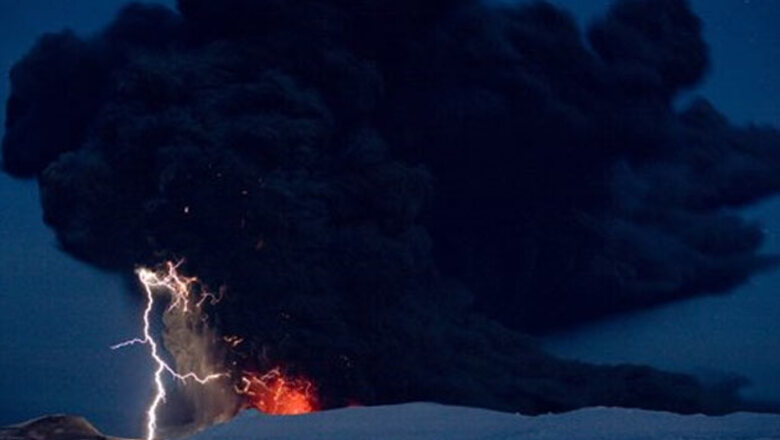
views
Mount Merapi: International airlines canceled flights into Indonesia's capital on Saturday after a volcano hundreds of miles to the west unleashed its most powerful eruption in a century, incinerating villagers as they fled a searing gas cloud. The number of people killed by Mount Merapi in the last two weeks climbed to 138, as a tiny hospital at the foot of the mountain struggled to cope with survivors, some with burns on up to 95 per cent of their bodies.
The only sign of life in one man, whose eyes were milky gray in colour and never blinked, was the shallow rising and falling of his chest. Others, their lungs choked with abrasive volcanic ash, struggled to breathe.
Indonesia's most volatile mountain unleashed a surge of searing gas, rocks and debris on Friday that raced down its slopes at highway speeds, mowing down the slope-side village of Bronggang and leaving a trail of charred corpses in its path.
It continued to rumble and groan on Saturday, at times spitting ash up to five miles (eight kilometers) in the air, dusting windshields, rooftops and leaves on trees hundreds of miles to the west.
Just days before President Barack Obama's visit to Indonesia, international carriers canceled flights to the capital, Jakarta, over concerns about the volcano, 280 miles (450 kilometers) away. "The volcanic ash presence in the airways surrounding Jakarta could cause severe damage to our aircraft and engines, which could impair the safety of our operations including passengers and crew," said Azharuddin Osman, director of operations for Malaysia Airlines.
Among the other carriers temporarily suspending flights were Singapore Airlines, Cathay Pacific, Japan Airlines, Lufthansa, Malaysia Airlines and AirAsia. Domestic flights were unaffected, except for those going to Yogyakarta, the city closest to the volcano whose airport closed on Friday.
The eruption of Iceland's Eyjafjallajokul volcano in April forced the closure of most European airports for a week and led to the cancellation of over 100,000 flights.
But Tia Wanti, an information officer at Jakarta's international airport, implied the move was premature, saying the dust wasn't causing problems either in the skies above the airport or on its runways. The airport handles about 1,200 flights a day, and the airline decisions caused about 10 per cent of those to be canceled.
The Indonesian government, meanwhile, has expanded a "danger zone" to a ring 12 miles (20 kilometers) from the peak, bringing it to the edge of the ancient royal capital of Yogyakarta, which has been put on its highest alert.
The biggest threat is the Code River, which flows into the city of 400,000 from the 9,700-foot (3,000-meter) mountain and could act as a conduit for deadly volcanic mudflows that form in heavy rains. Racing at speeds of 60 mph (100 kph), the molten lava, rocks and other debris, can destroy everything in their path. People living near the river's banks have been advised to stay away. Sigit Priohutomo, a senior hospital official, said the mountain has killed 138 in the last two weeks.
At least 94 of those died Friday, Merapi's deadliest day in decades. More than 200 others were injured with burns, respiratory problems, broken bones and cuts, leaving the tiny hospital of Sardjito overwhelmed.
It has the only burn unit in town with just nine beds. And with nearby airports closed because of poor visibility, extra ventilators intended for burn victims could not be flown in, said Dr Ishandono Dahlan. In the meantime, nursing students were pumping emergency respirators by hand.
The small unit is forced to turn away all but the most severe cases, officials said. Those with severe smoke inhalation, which scorches and inflames lung tissue, making breathing difficult if not impossible, get top priority, since the only ventilators in the hospital are in the unit. Next, the severity and extent of burns are considered.
Dahlan, who is a plastic surgeon, said he has eight ventilators, not even one for every bed in the unit, and needs at least four more. It was unclear when he would get them.
Even patients with more mild cases of smoke inhalation who weren't on the special ward needed access to the machines, he said. "If they're not on a ventilator, they're inhaling more ash," said Dahlan.
The unit is supposed to be the most sterile in the hospital since burns are essentially open wounds and prone to infection. While a pass code restricts entry, Dahlan said it's a struggle to keep the unit hermetic.
The air conditioning frequently breaks, so someone opens a window. The entryway has double doors, but the interior set are often left open, meaning the whole unit is exposed whenever anyone enters. Visitors are asked to come in one at a time, and to don cotton gowns and masks, but the rules are easily broken and the gowns have begun to feel grimy.
Still, conditions on the unit are far better than in the rest of the hospital. Many wards are not sealed off at all, with only a swinging door to the outside.
Families crowd the hallways, sleeping on mats, and a sprinkling of dust covers everything, from the stretchers to the doctors' white coats.
Conditions were also deteriorating at emergency shelters in the shadow of the volcano that were crammed with more than 200,000 people evacuated from the mountain.
With muddy floors, flies landing on the faces of sleeping refugees, many complained of poor sanitation, saying there were not enough toilets or clean drinking water. They also worried about what was yet to come.
"It's scary. ... The eruption just keeps going on," said Wajiman, 58, who was sitting in a shelter near a girl reading a newspaper headlined "Merapi isn't finished yet."
Merapi's latest round of eruptions began October 26, followed by more than a dozen other powerful blasts and thousands of tremors. With each new eruption, scientists and officials have steadily pushed the villagers who live along Merapi's slopes farther from the crater.
The latest eruption released 1,765 million cubic feet (50 million cubic meters) of volcanic material, making it "the biggest in at least a century" at Merapi, state volcanologist Gede Swantika said as plumes of smoke continued to shoot up more than 30,000 feet (10,000 meters).
Indonesia, a vast archipelago of 235 million people, is prone to earthquakes and volcanoes because it sits along the Pacific "Ring of Fire," a horseshoe-shaped string of faults that lines the Pacific Ocean.




















Comments
0 comment